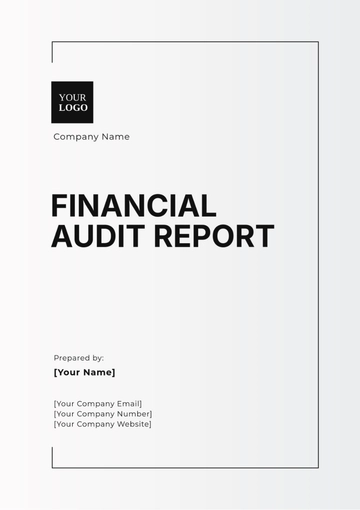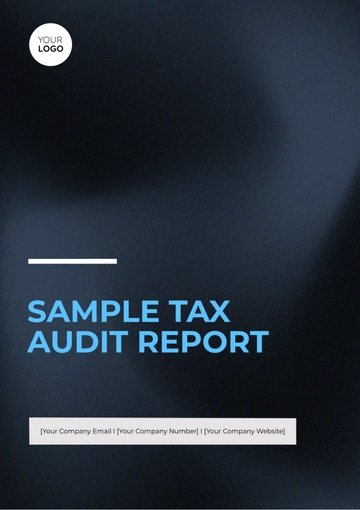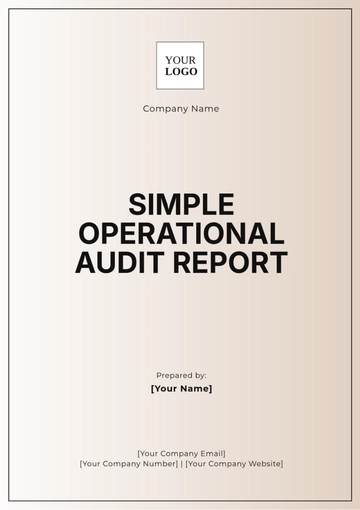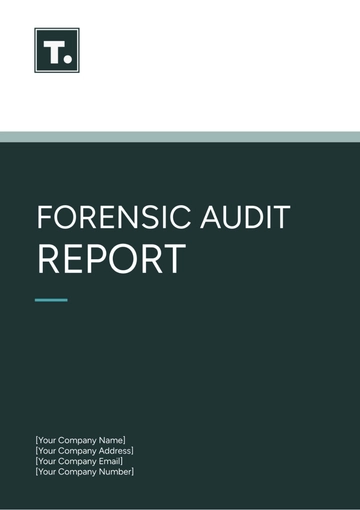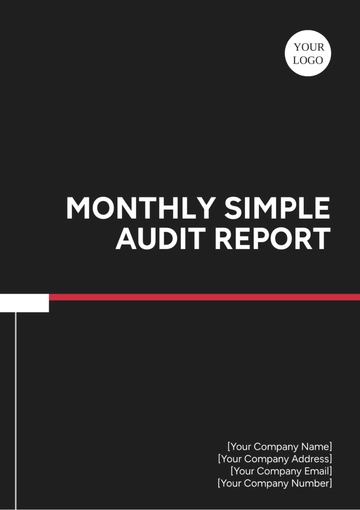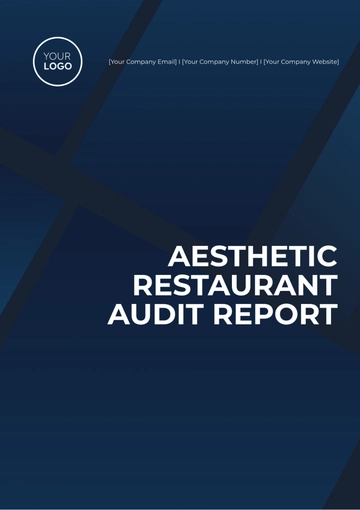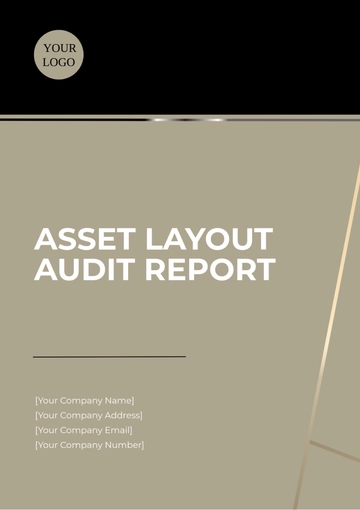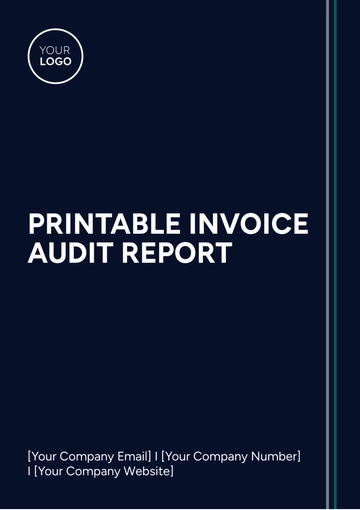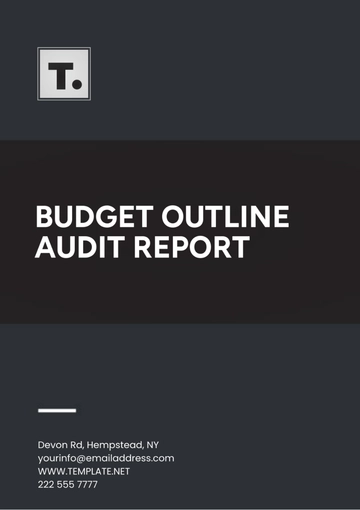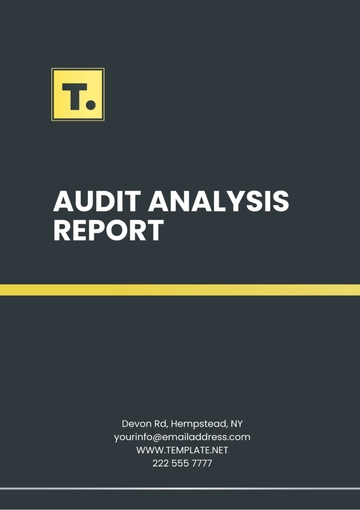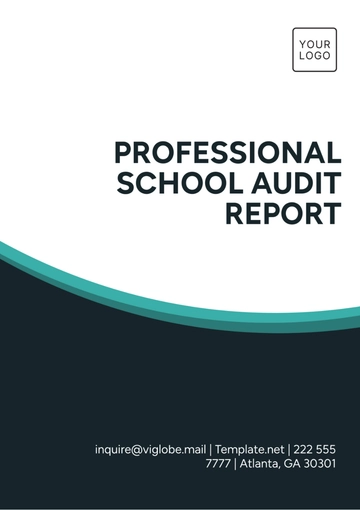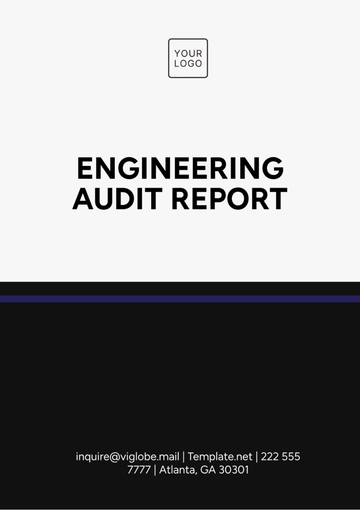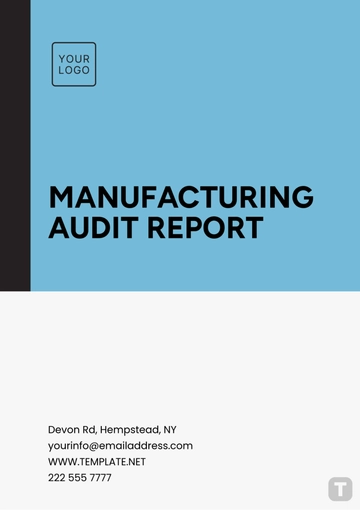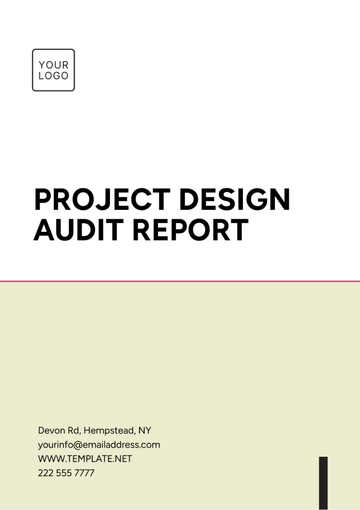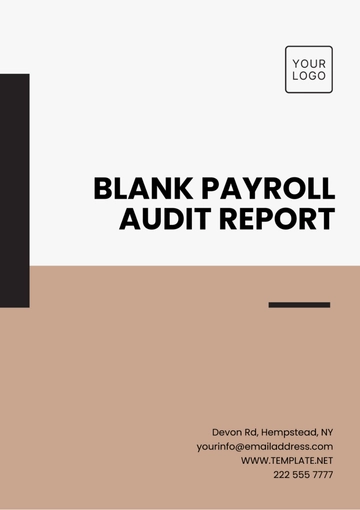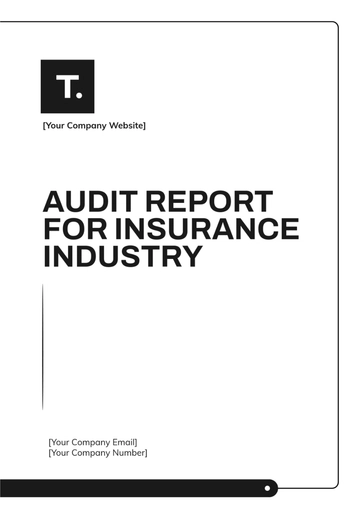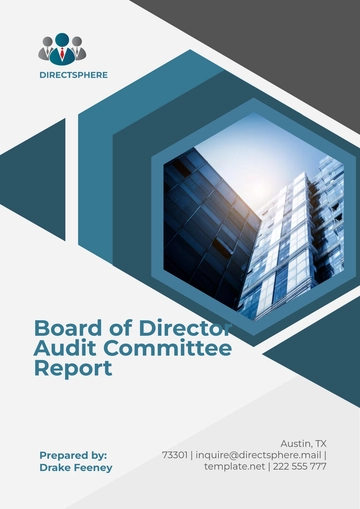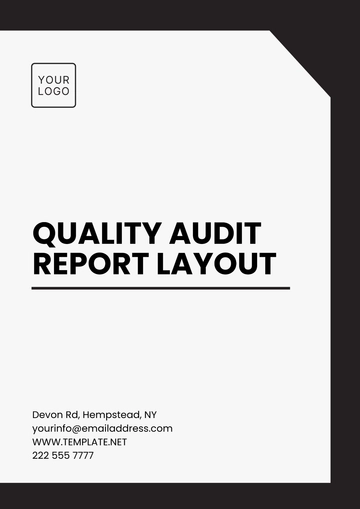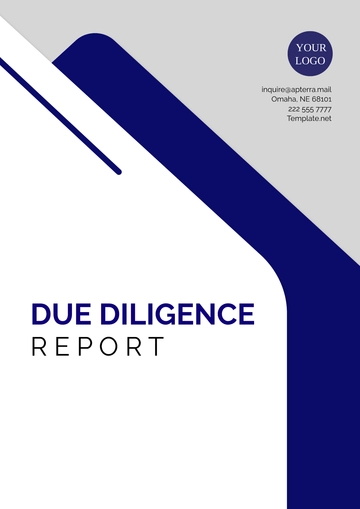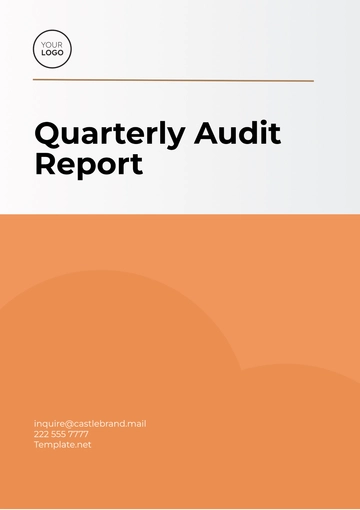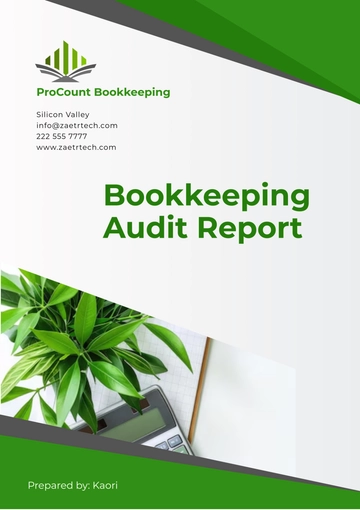Free Operations Quality Audit Findings Report
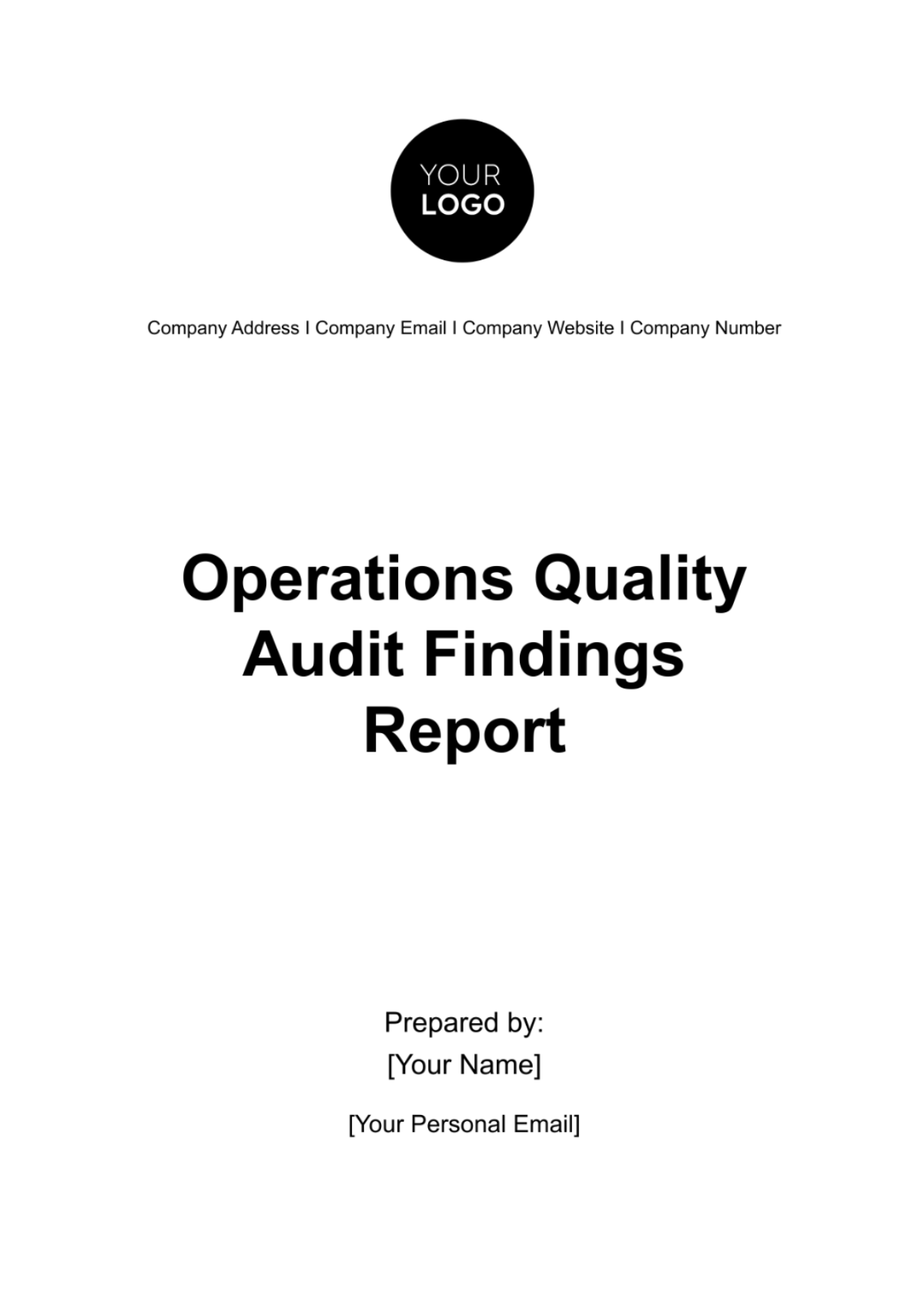
I. Executive Summary
The Operations Quality Audit Findings Report provides a comprehensive overview of the recent audit conducted by [Your Company Name] to assess the quality management processes and practices within the operations department. This report highlights key findings, observations, non-conformities, root cause analyses, corrective actions, and recommendations identified during the audit.
II. Introduction
The purpose of this report is to communicate the outcomes of the operations quality audit conducted by [Your Company Name]'s internal audit team. The audit aimed to evaluate the effectiveness, efficiency, and compliance of quality management processes and procedures within the operations department against established standards, regulations, and organizational requirements.
III. Audit Objectives
The objectives of the operations quality audit were to:
Assess the implementation and effectiveness of quality management systems and practices within the operations department.
Identify areas of improvement, potential risks, and opportunities for enhancing quality performance and compliance.
Ensure alignment with regulatory requirements, industry standards, and organizational quality objectives.
IV. Scope of Audit
The scope of the operations quality audit encompassed a comprehensive assessment of quality management processes, procedures, and practices within the operations department of [Your Company Name]. The audit covered the following areas:
Process Documentation and Compliance: Review and evaluation of documented procedures, work instructions, and quality management system documentation to assess alignment with regulatory requirements, industry standards, and organizational policies. The audit examined the extent to which operational processes were documented, communicated, and followed by personnel to ensure consistency, standardization, and compliance.
Process Controls and Monitoring Mechanisms: Assessment of process controls, monitoring mechanisms, and performance metrics implemented within operational processes to ensure effective management and control of quality-related activities. The audit evaluated the adequacy and effectiveness of process controls, including checks, inspections, validations, and verifications, to identify deviations, prevent errors, and ensure product and service quality.
Compliance with Quality Standards and Specifications: Evaluation of adherence to quality standards, specifications, and requirements applicable to operational activities, products, and services. The audit assessed the extent to which operational processes complied with established quality standards, customer specifications, regulatory requirements, and industry best practices to ensure product safety, reliability, and customer satisfaction.
Resource Utilization and Optimization: Examination of resource utilization, allocation, and optimization practices within the operations department to maximize efficiency, productivity, and quality performance. The audit analyzed resource allocation strategies, staffing levels, skills, equipment, and facilities to identify opportunities for improvement, cost reduction, and capacity enhancement while maintaining quality standards.
Supplier Quality Management Practices: Review of supplier quality management practices, processes, and performance to assess the effectiveness of supplier qualification, monitoring, and collaboration mechanisms. The audit examined supplier quality agreements, performance metrics, audits, and corrective action processes to ensure supplier compliance with quality requirements and mitigate supply chain risks.
Customer Feedback and Complaint Handling: Assessment of customer feedback mechanisms, complaint handling processes, and corrective action procedures to address customer concerns, complaints, and quality-related issues effectively. The audit evaluated the responsiveness, timeliness, and effectiveness of customer feedback handling, resolution, and follow-up processes to enhance customer satisfaction and loyalty.
Continuous Improvement Initiatives: Examination of continuous improvement initiatives, programs, and practices implemented within the operations department to drive quality excellence, innovation, and process optimization. The audit assessed the culture of continuous improvement, employee engagement, problem-solving capabilities, and implementation of improvement projects to foster a culture of excellence and innovation.
V. Audit Methodology
The operations quality audit was conducted using a systematic and structured approach to ensure thoroughness, objectivity, and effectiveness in assessing quality management processes within the operations department. The following methodology was employed:
A. Pre-Audit Planning
The audit team conducted pre-audit planning activities to define audit objectives, scope, criteria, and methodology. Planning activities included the development of an audit plan, identification of key stakeholders, allocation of resources, and establishment of communication channels to ensure alignment with audit objectives and organizational requirements.
B. Document Review
The audit team conducted a comprehensive review of relevant documentation, including quality manuals, procedures, work instructions, process maps, records, and regulatory requirements. Document reviews enabled the audit team to gain insights into the documented quality management systems, processes, and controls in place within the operations department.
C. Interviews and Information Gathering
Interviews were conducted with key personnel, including operations managers, quality assurance professionals, process owners, and frontline staff, to gather information, insights, and perspectives on quality management practices, challenges, and opportunities within the operations department. Interviews provided valuable qualitative data to supplement document reviews and validate findings.
D. Process Observations
The audit team conducted on-site process observations to directly observe operational processes, activities, and practices in real-time. Process observations enabled the audit team to assess the effectiveness of process controls, adherence to documented procedures, and compliance with quality standards. Observations were conducted discreetly to minimize disruption to ongoing operations.
E. Data Analysis
Quantitative data analysis was performed using statistical techniques, trend analysis, and performance metrics to assess process performance, identify patterns, outliers, and areas of variation. Data analysis provided objective insights into process efficiency, effectiveness, and compliance with quality standards, enabling the audit team to identify areas for improvement and prioritize corrective actions.
F. Sampling Techniques
Sampling techniques, including random sampling, stratified sampling, and purposive sampling, were employed to select representative samples of processes, transactions, or records for audit testing. Sampling enabled the audit team to draw conclusions about the entire population based on the analysis of a subset, ensuring efficiency and effectiveness in audit procedures.
G. Risk-Based Approach
A risk-based approach was adopted to prioritize audit focus areas, allocate resources, and tailor audit procedures based on the significance of risks to quality performance and organizational objectives. Risk assessments were conducted to identify and prioritize high-risk processes, activities, or areas requiring heightened scrutiny and attention during the audit.
VI. Findings and Observations
Key findings and observations from the operations quality audit include:
Inconsistent adherence to documented procedures and standards across operational processes.
Lack of adequate documentation and record-keeping practices in certain areas.
Instances of deviations from quality specifications and requirements.
Opportunities for streamlining processes, enhancing resource utilization, and improving quality performance.
Inefficiencies in workflow processes leading to delays and bottlenecks.
Lack of clarity in roles and responsibilities contributing to confusion and errors.
Insufficient training and competency development programs for frontline staff.
Inadequate monitoring and measurement of process performance metrics.
Inconsistent application of quality control measures leading to variability in output quality.
Non-compliance with regulatory requirements and industry standards in certain areas.
Communication breakdowns and silos between departments impacting collaboration and coordination.
Lack of effective root cause analysis processes to address recurring quality issues.
Inadequate preventive maintenance practices resulting in equipment downtime and quality disruptions.
Limited visibility into supplier performance and quality risks within the supply chain.
Challenges in implementing corrective actions and sustaining quality improvements over time.
VII. Non-Conformities
During the operations quality audit, the following non-conformities were identified:
Failure to follow established procedures and protocols leading to inconsistencies in process execution.
Lack of documentation or incomplete records for critical processes and activities.
Deviations from quality standards and specifications resulting in product defects or service errors.
Inadequate controls or oversight leading to the occurrence of quality-related incidents.
Insufficient training or competency gaps among personnel impacting quality performance.
Non-compliance with regulatory requirements, industry standards, or customer expectations.
Weaknesses in supplier management processes contributing to quality risks in the supply chain.
Ineffective corrective and preventive actions to address identified quality issues.
Deficiencies in equipment maintenance practices leading to reliability and performance issues.
Communication breakdowns or misunderstandings impacting quality coordination and collaboration.
Lack of root cause analysis processes to identify and address underlying quality problems.
Inconsistent application of quality control measures across different operational areas.
Limited visibility or transparency into quality-related processes, metrics, or performance indicators.
VIII. Root Cause Analysis
Root cause analysis was conducted to determine the underlying factors contributing to identified non-conformities. Through this, [Your Company Name] aimed to uncover the underlying systemic issues, process deficiencies, or organizational factors contributing to non-conformities, enabling targeted corrective actions and quality improvement initiatives.
A. Problem Identification
The first step in root cause analysis involved clearly defining the problem or non-conformity, including its nature, scope, and impact on quality performance. The audit team identified specific incidents, deviations, or quality-related issues that warranted further investigation and analysis.
B. Data Collection and Analysis
Relevant data and information were collected to understand the sequence of events leading to the non-conformity. This included reviewing documentation, conducting interviews, analyzing process data, and gathering input from stakeholders involved in the affected processes.
C. Fishbone Diagram or Ishikawa Diagram
A fishbone diagram, also known as an Ishikawa diagram, was utilized to visually map out potential root causes contributing to the non-conformity. The diagram helped to categorize and organize potential causes into distinct categories, such as people, process, equipment, materials, environment, and management.
D. 5 Whys Technique
The 5 Whys technique was employed to delve deeper into the underlying reasons behind each identified root cause. By repeatedly asking "why" at least five times for each root cause, the audit team aimed to uncover the deeper systemic issues or root causes driving the non-conformity.
E. Pareto Analysis
Pareto analysis was conducted to prioritize root causes based on their frequency, severity, or impact on quality performance. This involved identifying the most significant or recurring root causes that contributed to the majority of non-conformities or quality-related incidents.
F. Validation and Verification
Once potential root causes were identified and analyzed, validation and verification activities were undertaken to confirm the accuracy and reliability of findings. This involved cross-referencing data, seeking input from subject matter experts, and conducting additional investigations if necessary.
G. Root Cause Identification
Based on the analysis conducted, the audit team identified the primary root causes or contributing factors responsible for the non-conformity. These root causes were documented and prioritized based on their significance, likelihood of recurrence, and potential impact on quality performance.
IX. Corrective Actions
To address the root causes and non-conformities identified during the operations quality audit, the following corrective actions were proposed and implemented:
Process Improvements: Implementation of enhanced procedures, work instructions, or standard operating protocols to address identified deficiencies, streamline processes, and improve process efficiency and effectiveness.
Training and Skill Development: Provision of targeted training programs, workshops, or skill development sessions to address competency gaps, improve employee knowledge and skills, and ensure adherence to quality standards and procedures.
Quality Control Enhancements: Implementation of additional quality control measures, checkpoints, or inspection procedures to prevent recurrence of quality-related issues, detect deviations early, and ensure compliance with quality specifications.
Supplier Collaboration and Improvement: Collaboration with key suppliers to address quality concerns, enhance communication, and implement corrective actions to improve supplier performance, product quality, and supply chain reliability.
Equipment Maintenance and Calibration: Implementation of preventive maintenance schedules, calibration programs, and equipment reliability initiatives to ensure equipment integrity, reliability, and performance, thereby reducing the risk of quality disruptions.
Communication and Collaboration Enhancements: Enhancement of communication channels, cross-functional collaboration, and information-sharing mechanisms to facilitate better coordination, problem-solving, and decision-making related to quality management.
Root Cause Elimination: Implementation of solutions aimed at addressing the root causes identified during root cause analysis, including systemic issues, process deficiencies, or organizational factors contributing to non-conformities.
Performance Monitoring and Metrics Tracking: Establishment of performance metrics, key performance indicators (KPIs), and monitoring mechanisms to track progress, measure the effectiveness of corrective actions, and ensure sustained quality improvement over time.
Audits and Reviews: Conducting regular audits, reviews, or assessments to monitor compliance, identify emerging issues, and verify the effectiveness of implemented corrective actions in mitigating quality risks.
Continuous Improvement Initiatives: Integration of continuous improvement principles and practices into organizational culture to foster a mindset of ongoing learning, innovation, and excellence in quality management.
X. Recommendations
Based on the findings and observations of the operations quality audit, the following recommendations are proposed to further enhance quality management practices and improve overall quality performance within the operations department:
Enhance Documentation Practices: Implement standardized documentation procedures and templates to ensure consistency, completeness, and accuracy of records for all operational processes and activities.
Strengthen Training and Development Programs: Develop comprehensive training programs tailored to the needs of frontline staff, supervisors, and managers to enhance skills, competencies, and awareness related to quality management principles and practices.
Improve Process Control and Monitoring: Enhance process control measures, real-time monitoring systems, and performance metrics to enable proactive identification of deviations, trends, and opportunities for process optimization.
Streamline Communication Channels: Establish clear communication channels, escalation protocols, and feedback mechanisms to facilitate effective communication, collaboration, and problem-solving across departments and teams.
Enhance Supplier Management Practices: Strengthen supplier evaluation, selection, and performance monitoring processes to ensure alignment with quality standards, regulatory requirements, and organizational expectations.
Implement Root Cause Analysis Framework: Develop a systematic approach to root cause analysis, including standardized tools, techniques, and training to enable personnel to identify, analyze, and address underlying causes of non-conformities effectively.
Establish Continuous Improvement Culture: Foster a culture of continuous improvement by encouraging employee engagement, empowerment, and participation in quality improvement initiatives, innovation projects, and problem-solving activities.
Invest in Technology Solutions: Explore the adoption of technology solutions, such as quality management software, data analytics tools, and digital platforms, to automate processes, enhance data visibility, and facilitate informed decision-making.
Conduct Regular Quality Audits and Reviews: Schedule periodic quality audits, reviews, and assessments to monitor progress, verify compliance with quality standards, and identify emerging issues or areas for improvement.
Promote Customer-Centric Approach: Embed a customer-centric mindset throughout the organization by prioritizing customer feedback, expectations, and satisfaction as key drivers of quality improvement initiatives.
XI. Conclusion
In conclusion, the operations quality audit findings highlight areas of improvement and opportunities for enhancing quality performance within the operations department. By implementing corrective actions and recommendations, [Your Company Name] aims to strengthen its quality management practices, ensure compliance with standards and regulations, and drive continuous improvement in operations quality.
- 100% Customizable, free editor
- Access 1 Million+ Templates, photo’s & graphics
- Download or share as a template
- Click and replace photos, graphics, text, backgrounds
- Resize, crop, AI write & more
- Access advanced editor
Ensure operational excellence with Template.net's Operations Quality Audit Findings Report Template—an essential tool for startups to assess and improve quality performance. Available on Template.net and customizable in our AI Editor Tool, this editable resource empowers you to document audit findings, identify areas for improvement, and propose corrective actions to enhance quality standards.
You may also like
- Sales Report
- Daily Report
- Project Report
- Business Report
- Weekly Report
- Incident Report
- Annual Report
- Report Layout
- Report Design
- Progress Report
- Marketing Report
- Company Report
- Monthly Report
- Audit Report
- Status Report
- School Report
- Reports Hr
- Management Report
- Project Status Report
- Handover Report
- Health And Safety Report
- Restaurant Report
- Construction Report
- Research Report
- Evaluation Report
- Investigation Report
- Employee Report
- Advertising Report
- Weekly Status Report
- Project Management Report
- Finance Report
- Service Report
- Technical Report
- Meeting Report
- Quarterly Report
- Inspection Report
- Medical Report
- Test Report
- Summary Report
- Inventory Report
- Valuation Report
- Operations Report
- Payroll Report
- Training Report
- Job Report
- Case Report
- Performance Report
- Board Report
- Internal Audit Report
- Student Report
- Monthly Management Report
- Small Business Report
- Accident Report
- Call Center Report
- Activity Report
- IT and Software Report
- Internship Report
- Visit Report
- Product Report
- Book Report
- Property Report
- Recruitment Report
- University Report
- Event Report
- SEO Report
- Conference Report
- Narrative Report
- Nursing Home Report
- Preschool Report
- Call Report
- Customer Report
- Employee Incident Report
- Accomplishment Report
- Social Media Report
- Work From Home Report
- Security Report
- Damage Report
- Quality Report
- Internal Report
- Nurse Report
- Real Estate Report
- Hotel Report
- Equipment Report
- Credit Report
- Field Report
- Non Profit Report
- Maintenance Report
- News Report
- Survey Report
- Executive Report
- Law Firm Report
- Advertising Agency Report
- Interior Design Report
- Travel Agency Report
- Stock Report
- Salon Report
- Bug Report
- Workplace Report
- Action Report
- Investor Report
- Cleaning Services Report
- Consulting Report
- Freelancer Report
- Site Visit Report
- Trip Report
- Classroom Observation Report
- Vehicle Report
- Final Report
- Software Report

